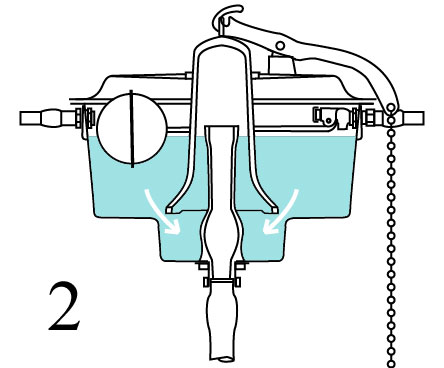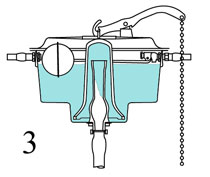Burlington bell cistern
The Burlington, or bell, style cistern is only suitable for high level cisterns and is now considered old fashion but can still be found in old houses or houses refurbished to be true to their Victorian age.
 Burlington cisterns are normally made from cast iron and can be easily recognised by the 'well' in the base into which the 'bell' fits.
Burlington cisterns are normally made from cast iron and can be easily recognised by the 'well' in the base into which the 'bell' fits.
The down-flow pipe to the lavatory pan is within the bell and the open top is just above the normal water level in the cistern - Fig. 1.
 When the cistern chain is pulled, the lever at the top of the cistern lifts the bell out of the well allowing water to flow under the bell - Fig. 2.
When the cistern chain is pulled, the lever at the top of the cistern lifts the bell out of the well allowing water to flow under the bell - Fig. 2.
 When the cistern chain is then released, the bottom of the bell contains the water underneath as it falls into the well, forcing the water up inside the bell and over, into the downpipe which starts the syphon effect - Fig. 3 - drawing the rest of the water from the cistern until air is drawn under the bottom of the bell.
When the cistern chain is then released, the bottom of the bell contains the water underneath as it falls into the well, forcing the water up inside the bell and over, into the downpipe which starts the syphon effect - Fig. 3 - drawing the rest of the water from the cistern until air is drawn under the bottom of the bell.
The Burlington bell style cistern does not have any parts to wear and so is highly reliable. Their weaknesses are:
- If the water level is set too low, they can be temperamental in operation as if insufficient water goes down the pipe when the bell is dropped, it will not start the syphon effect. Low water levels can be remedied by adjust the float controlling the water inlet valve as described on the 'Common problems with lavatory cisterns' page.
- Burlington bell style cisterns tend to be mechanically noisy as the top lever pivots and the iron bell is dropped.
Although there are these drawbacks, using a well set-up and preserved Burlington bell style cistern in the appropriate position does add style without compromising on modern living.
